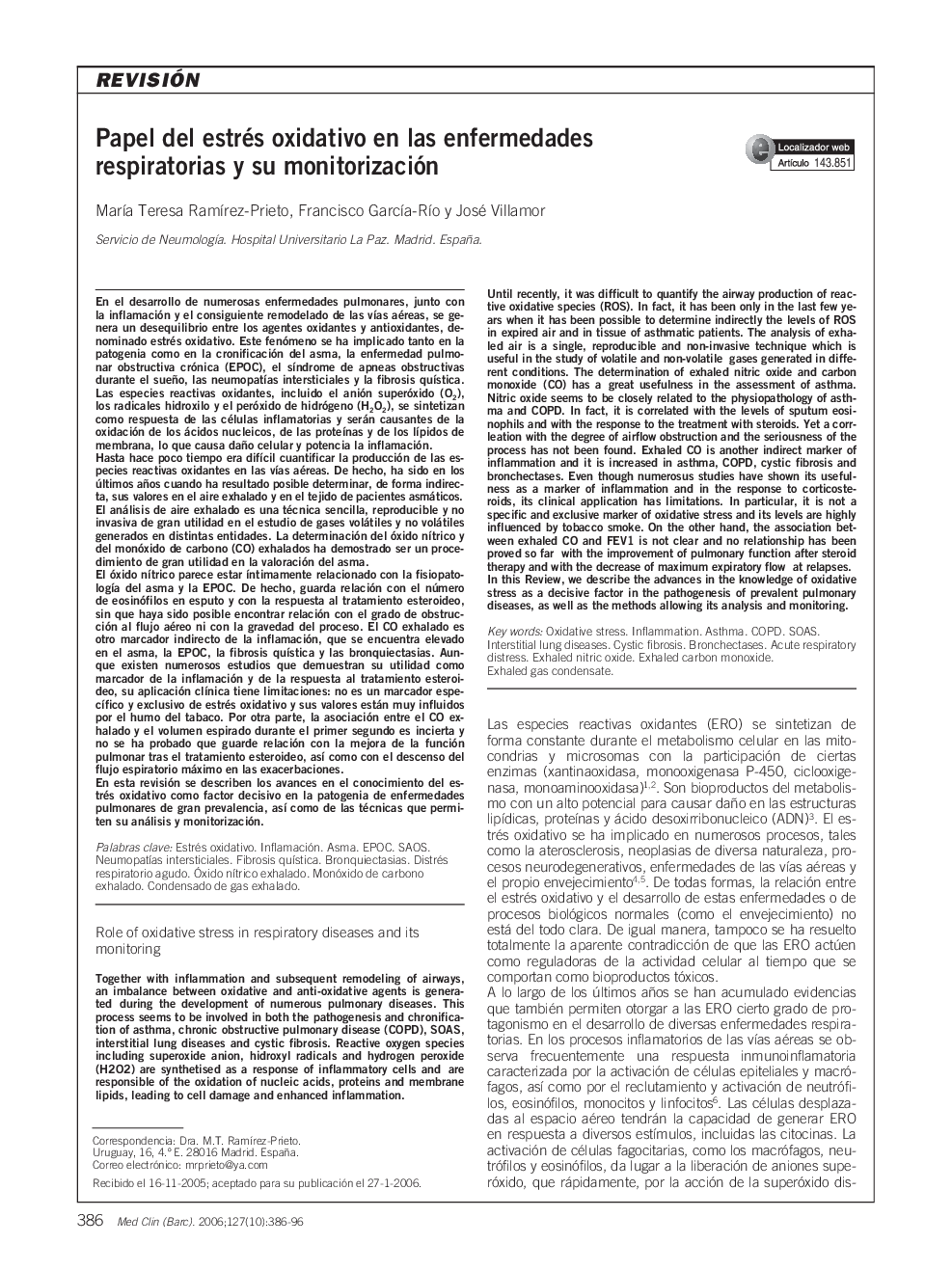| کد مقاله | کد نشریه | سال انتشار | مقاله انگلیسی | نسخه تمام متن |
|---|---|---|---|---|
| 3802387 | 1244800 | 2006 | 11 صفحه PDF | دانلود رایگان |

En el desarrollo de numerosas enfermedades pulmonares, junto con la inflamación y el consiguiente remodelado de las vÃas aéreas, se genera un desequilibrio entre los agentes oxidantes y antioxidantes, denominado estrés oxidativo. Este fenómeno se ha implicado tanto en la patogenia como en la cronificación del asma, la enfermedad pulmonar obstructiva crónica (EPOC), el sÃndrome de apneas obstructivas durante el sueño, las neumopatÃas intersticiales y la fibrosis quÃstica.Las especies reactivas oxidantes, incluido el anión superóxido (O2), los radicales hidroxilo y el peróxido de hidrógeno (H2O2), se sintetizan como respuesta de las células inflamatorias y serán causantes de la oxidación de los ácidos nucleicos, de las proteÃnas y de los lÃpidos de membrana, lo que causa daño celular y potencia la inflamación.Hasta hace poco tiempo era difÃcil cuantificar la producción de las especies reactivas oxidantes en las vÃas aéreas. De hecho, ha sido en los últimos años cuando ha resultado posible determinar, de forma indirecta, sus valores en el aire exhalado y en el tejido de pacientes asmáticos.El análisis de aire exhalado es una técnica sencilla, reproducible y no invasiva de gran utilidad en el estudio de gases volátiles y no volátiles generados en distintas entidades. La determinación del óxido nÃtrico y del monóxido de carbono (CO) exhalados ha demostrado ser un procedimiento de gran utilidad en la valoración del asma.El óxido nÃtrico parece estar Ãntimamente relacionado con la fisiopatologÃa del asma y la EPOC. De hecho, guarda relación con el número de eosinófilos en esputo y con la respuesta al tratamiento esteroideo, sin que haya sido posible encontrar relación con el grado de obstrucción al flujo aéreo ni con la gravedad del proceso. El CO exhalado es otro marcador indirecto de la inflamación, que se encuentra elevado en el asma, la EPOC, la fibrosis quÃstica y las bronquiectasias. Aunque existen numerosos estudios que demuestran su utilidad como marcador de la inflamación y de la respuesta al tratamiento esteroideo, su aplicación clÃnica tiene limitaciones: no es un marcador especÃfico y exclusivo de estrés oxidativo y sus valores están muy influidos por el humo del tabaco. Por otra parte, la asociación entre el CO exhalado y el volumen espirado durante el primer segundo es incierta y no se ha probado que guarde relación con la mejora de la función pulmonar tras el tratamiento esteroideo, asà como con el descenso del flujo espiratorio máximo en las exacerbaciones.En esta revisión se describen los avances en el conocimiento del estrés oxidativo como factor decisivo en la patogenia de enfermedades pulmonares de gran prevalencia, asà como de las técnicas que permiten su análisis y monitorización.
Together with inflammation and subsequent remodeling of airways, an imbalance between oxidative and anti-oxidative agents is generated during the development of numerous pulmonary diseases. This process seems to be involved in both the pathogenesis and chronification of asthma, chronic obstructive pulmonary disease (COPD), SOAS, interstitial lung diseases and cystic fibrosis. Reactive oxygen species including superoxide anion, hidroxyl radicals and hydrogen peroxide (H2O2) are synthetised as a response of inflammatory cells and are responsible of the oxidation of nucleic acids, proteins and membrane lipids, leading to cell damage and enhanced inflammation.Until recently, it was difficult to quantify the airway production of reactive oxidative species (ROS). In fact, it has been only in the last few years when it has been possible to determine indirectly the levels of ROS in expired air and in tissue of asthmatic patients. The analysis of exhaled air is a single, reproducible and non-invasive technique which is useful in the study of volatile and non-volatile gases generated in different conditions. The determination of exhaled nitric oxide and carbon monoxide (CO) has a great usefulness in the assessment of asthma.Nitric oxide seems to be closely related to the physiopathology of asthma and COPD. In fact, it is correlated with the levels of sputum eosinophils and with the response to the treatment with steroids. Yet a corrleation with the degree of airflow obstruction and the seriousness of the process has not been found. Exhaled CO is another indirect marker of inflammation and it is increased in asthma, COPD, cystic fibrosis and bronchectases. Even though numerosus studies have shown its usefulness as a marker of inflammation and in the response to corticosteroids, its clinical application has limitations. In particular, it is not a specific and exclusive marker of oxidative stress and its levels are highly influenced by tobacco smoke. On the other hand, the association between exhaled CO and FEV1 is not clear and no relationship has been proved so far with the improvement of pulmonary function after steroid therapy and with the decrease of maximum expiratory flow at relapses.In this Review, we describe the advances in the knowledge of oxidative stress as a decisive factor in the pathogenesis of prevalent pulmonary diseases, as well as the methods allowing its analysis and monitoring.
Journal: Medicina ClÃnica - Volume 127, Issue 10, September 2006, Pages 386-396